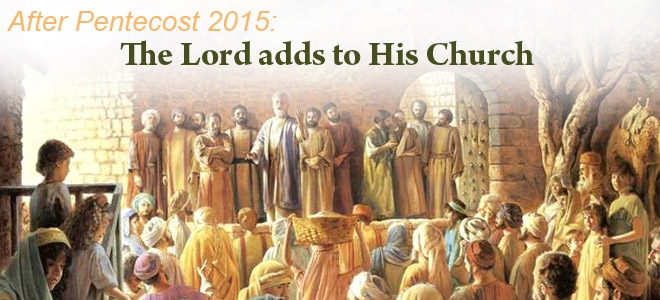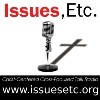After the events of the Day of Pentecost, the Lord added about 3,000 souls to His Church (Acts 2:41), and He continues to add to His Church even today, though means and the resulting numbers are seldom that dramatic. In the Divine Service, believers devote themselves both to the apostles’ teaching in the Service of the Word and to the fellowship—that is, the breaking of bread and prayers—in the Service of the Sacrament, and the Lord adds to their number day by day those who are being saved (Acts 2:42, 47; confer 5:14 and 11:24). The Sundays after Pentecost in a sense both focus on and lead to such growth.
The Day of Pentecost serves as a transition of a sort from the Easter Season and the festival half of the Church Year to the Season of Sundays after Pentecost and the non-festival half of the Church Year. The Day of Pentecost described in Acts 2 with its harvest of souls to the Church came 50 days after the Resurrection of the Lord, just as the Old Testament festival of Pentecost (also called the Feast of Weeks) came 50 days after Passover and the presentation of the first fruits of the wheat harvest (see, for example, Leviticus 23:15-21). The Gospel Reading for the Day of Pentecost (John 15:26-27; 16:4b-15) is some of Jesus’s teaching about the work of the Holy Spirit.
With agrarian societies at the time of the Bible, agricultural figures of speech not surprisingly were used to relate truths about the growth of the Church, and the Sundays after Pentecost present us with several of them. For example, in the parable in Mark 4:26-29, Jesus likens His Kingdom to a man scattering seed on the ground without knowing how it grows on its own. Although in that parable Jesus might be taken to suggest people do not know how the Kingdom of the Church grows, based on Scripture as a whole, we Lutherans believe, teach, and confess that the Holy Spirit works through the Office of the Holy Ministry’s purely preaching the Gospel and rightly administering the Sacraments to create saving faith when and where He pleases in those who hear the Gospel, which teaches that we have a gracious God by the merit of Christ, when we believe this (Augsburg Confession V:1-3).
That gracious God is Triune, as is particularly recalled on the First Sunday after Pentecost, also called the Feast of the Holy Trinity, which celebrates the richness of the Triune God: Father, Son, and Holy Spirit—three Persons of one divine substance. Within the Trinity, the Father begets the Son, the Son is begotten, and the Holy Spirit proceeds at least from the Father. Outside the Trinity, God’s works generally can be ascribed to any of the three Persons, although only the Son was sent by the Father to take on human flesh and so die and rise in order to save us from our sins by grace through faith that the Holy Spirit creates. The Gospel Reading for the Feast of the Holy Trinity (John 3:1-17) speaks of the Father sending the Son to save and of the Holy Spirit giving birth from above in the water of Holy Baptism.
For the rest of the Sundays after Pentecost, the dates and Gospel Readings (according to Lutheran Service Book Series B, largely using the Holy Gospel according to St. Mark) are listed below. In this particular Church Year, you may note that one Sunday after Pentecost (11/01) is replaced by an observance of the Feast of All Saints’ Day (Matthew 5:1-12).
- Second Sunday (06/07): Jesus’s true family consists of believers (Mark 3:20-35)
- Third Sunday (06/14): Jesus’s Kingdom grows like a seed (Mark 4:26-34)
- Fourth Sunday (06/21): Jesus calms the storms in our lives (Mark 4:35-41)
- Fifth Sunday (06/28: Jesus heals and raises from the dead (Mark 5:21-43)
- Sixth Sunday (07/05): Jesus is denied honor and sends others (Mark 6:1-13)
- Seventh Sunday (07/12): Jesus’s fame reaches King Herod (Mark 6:14-29)
- Eighth Sunday (07/19): Jesus shepherds and feeds His followers (Mark 6:30-44)
- Ninth Sunday (07/26): Jesus shows His power by walking on water (Mark 6:45-56)
- Tenth Sunday (08/02): Jesus says God works people’s faith (John 6:22-35)
- Eleventh Sunday (08/09): Jesus is the bread of life (John 6:35-51)
- Twelfth Sunday (08/16): Jesus gives flesh and blood to eat and drink (John 6:51-69)
- Thirteenth Sunday (08/23): Jesus speaks about “tradition” (Mark 7:1-13)
- Fourteenth Sunday (08/30): Jesus tells what does and does not defile (Mark 7:14-23)
- Fifteenth Sunday (09/06): Jesus opens ears and looses tongues (Mark 7:31-37)
- Sixteenth Sunday (09/13): Jesus drives out demons others cannot (Mark 9:14-29)
- Seventeenth Sunday (09/20): Jesus says the first must be last (Mark 9:30-37)
- Eighteenth Sunday (09/27): Jesus speaks of people for or against Him (Mark 9:38-50)
- Nineteenth Sunday (10/04): Jesus teaches about marriage and divorce (Mark 10:2-16)
- Twentieth Sunday (10/11): Jesus speaks of inheriting the Kingdom (Mark 10:17-22)
- Twenty-first Sunday (10/18): Jesus says all things are possible (Mark 10:23-31)
- Twenty-second Sunday (10/25): Jesus answers cries for mercy (Mark 10:46-52)
- Twenty-fourth Sunday (11/08): Jesus speaks of offerings (Mark 12:38-44)
- Twenty-fifth Sunday (11/15): Jesus speaks of the end times (Mark 13:1-13)
- Last Sunday of the Church Year (11/22): Jesus tells of the Last Day (Mark 13:24-37)
The last Sunday of the Church Year has also been variously observed as the Sunday of the Fulfillment or as Christ the King Sunday. Regardless of its title, the last Sunday looks forward to when all things in heaven and earth will be together under one head, Jesus Christ, and it thereby also itself transitions to the following season of Advent.
Special midweek observances during this season (and their Gospel Readings) are the Commemoration of the Presentation of the Augsburg Confession on June 25 (John 15:1-11); Reformation Day, observed on October 30 (John 8:31-36); and a Day of Thanksgiving, observed on its eve, November 25 (Luke 17:11-19).
Depending on what day you might come, you might find red, white, or green colored cloths on the pastor and furniture in the church. Red is the usual color for The Day of Pentecost, bringing to mind the fire of the Holy Spirit and the blood of the martyrs who died bearing His message. White is the usual color for Trinity Sunday, the Presentation of the Augsburg Confession, and the Day of National Thanksgiving, bringing to mind joy and glad celebrations, light and purity, and the innocence that is ours by Holy Baptism through which we receive Christ’s righteousness. Green is the usual color for all of the other days of the season, bringing to mind the life and growth evident in foliage and fruit.
Regardless of the season or day, everyone is always invited and welcome in person at Pilgrim Lutheran Church, and you usually can read and hear any of the sermons preached at Pilgrim here.
The image depicting the Day of Pentecost incorporated into the slider graphic and the banner graphic at the top of this page was found here, where the artist was not identified. We appreciate Candidate Christopher Nuttelman’s work preparing those and other graphics for our use.


